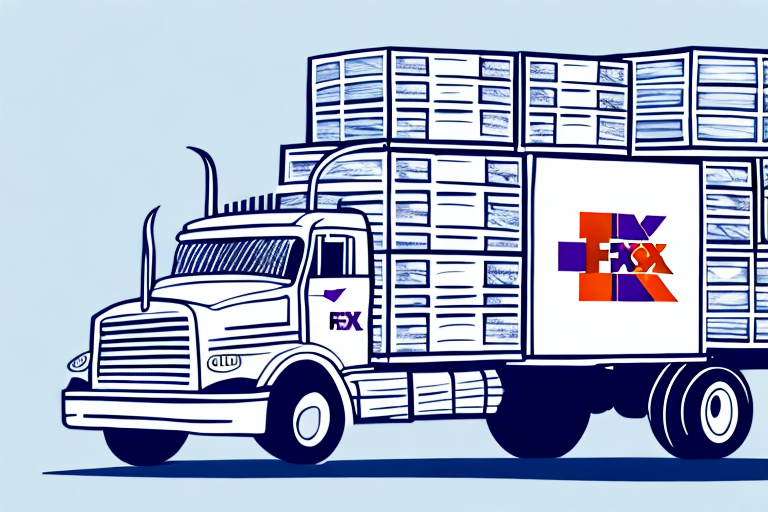What are Freight Volume Shipping Rates?
FedEx Freight Volume Shipping rates refer to the cost associated with shipping large and heavy items that exceed the weight or size limits of standard FedEx services like Ground or Express. These specialized services include features such as dedicated account representatives, customized shipping solutions, and time-definite delivery options, which are essential for businesses handling substantial shipments.
Freight Volume Shipping rates are determined by several factors, including the weight and dimensions of the shipment, the distance it needs to travel, and any additional services required, such as liftgate delivery or inside pickup. Businesses can request quotes tailored to their specific shipping needs and collaborate with their account representatives to find the most cost-effective and efficient shipping solutions.
How do Freight Volume Shipping Rates Work?
Freight Volume Shipping rates are calculated based on multiple parameters:
- Weight and Size: Heavier and larger shipments incur higher costs.
- Distance: Longer shipping distances increase the rate.
- Delivery Time: Faster delivery options may cost more.
- Origin and Destination: Locations with limited access or higher demand can affect pricing.
- Special Handling: Requirements like liftgate delivery or hazardous material handling add to the cost.
FedEx provides various tools, including online calculators and customer service support, to help businesses estimate their shipping costs accurately. Typically, Freight Volume Shipping rates are more economical compared to expedited or express services due to shipment consolidation, which optimizes space and resources. However, this can result in longer delivery times.
Additionally, the type of goods being shipped plays a significant role in determining the rates. Items classified as hazardous materials or oversized require special handling, which can increase shipping costs. Proper labeling and packaging are crucial to comply with regulations and avoid extra fees or delays.
Factors that Affect Freight Volume Shipping Rates
Several key factors influence Freight Volume Shipping rates:
- Shipment Weight and Size: Larger and heavier shipments cost more to transport.
- Travel Distance: Greater distances lead to higher rates.
- Origin and Destination: Specific locations may have additional charges based on accessibility and demand.
- Handling Requirements: Special equipment like liftgates or pallet jacks can increase costs.
- Seasonal Demand: Shipping rates may rise during peak seasons, such as holidays.
- Transportation Mode: Air freight is more expensive than sea or land but offers faster delivery.
- Goods Type: Hazardous, fragile, or oversized items may require additional safety measures, elevating the cost.
Choosing the appropriate mode of transportation and optimizing shipment characteristics can help manage and reduce Freight Volume Shipping costs effectively.
Freight Volume Shipping vs. Less-Than-Truckload (LTL) Shipping
While both Freight Volume Shipping and Less-Than-Truckload (LTL) shipping cater to businesses with varying shipment sizes, they serve different needs:
- Freight Volume Shipping: Ideal for large and heavy items that exceed FedEx's standard service limits. It offers direct shipments without additional stops, ensuring faster delivery.
- LTL Shipping: Suited for smaller and lighter shipments that can share truck space with other deliveries. It's cost-effective for shipments measuring less than 6 linear feet or weighing under 1,500 pounds.
While LTL shipping may offer lower rates for smaller shipments, it can result in longer delivery times due to multiple stops. In contrast, Freight Volume Shipping provides quicker delivery at a higher cost, benefiting businesses with urgent or substantial shipping requirements.
For more details on LTL shipping, visit our LTL shipping guide.
Benefits of Using FedEx Freight Volume Shipping Services
FedEx Freight Volume Shipping offers numerous advantages for businesses, including:
- Personalized Solutions: Tailored shipping plans to meet specific business needs.
- Time-Definite Delivery: Guaranteed delivery timelines enhance reliability.
- Dedicated Account Representatives: Expert support for managing shipments efficiently.
- Advanced Tracking and Security: Enhanced visibility and protection ensure safe and timely deliveries.
- Handling of Oversized Items: Capable of transporting large or difficult-to-ship goods seamlessly.
- Flexibility: Multiple service options allow businesses to choose based on their budget and urgency.
- Customized Pricing: Volume-based pricing helps businesses save on shipping costs.
- Value-Added Services: Additional options like liftgate delivery and inside pickup streamline the shipping process.
These benefits collectively contribute to efficient and cost-effective shipping operations for businesses relying on large-volume shipments.
Calculating and Estimating Freight Volume Shipping Rates
To accurately calculate and estimate Freight Volume Shipping rates, businesses can utilize FedEx's online tools or consult with customer service representatives. The estimation process involves providing:
- Shipment weight and dimensions
- Origin and destination locations
- Any additional handling requirements
FedEx also offers customized solutions for businesses with unique shipping needs, ensuring cost-effective and tailored options. It's important to note that:
- Transportation Mode: Air freight rates are higher than ground or sea but offer faster delivery.
- Distance: Greater distances increase shipping costs.
- Customs and Clearance Fees: International shipments may incur additional charges.
- Goods Type: Special handling for hazardous or fragile items can affect the overall cost.
Providing accurate shipment information is crucial for obtaining precise rate estimates and avoiding unexpected costs.
Tips for Reducing Shipping Costs with FedEx Freight Volume Shipping
Businesses can implement several strategies to minimize shipping costs when using FedEx Freight Volume Shipping services:
- Consolidate Shipments: Combining multiple shipments can reduce overall costs through economies of scale.
- Optimize Weight and Size: Efficient packaging and accurate measurement can prevent unnecessary fees.
- Utilize Time-Definite Delivery Options: Selecting appropriate delivery timelines can balance cost and urgency.
- Negotiate Better Rates: Partnering with FedEx for high-volume shipping can lead to discounted rates.
- Leverage Technology Solutions: Tools like online tracking, automated invoicing, and real-time rate quotes streamline operations and reduce administrative costs.
By adopting these practices, businesses can achieve significant savings on their shipping expenses while maintaining efficient logistics operations.
Common Mistakes to Avoid When Using FedEx Freight Volume Shipping Services
To ensure smooth and cost-effective shipments, businesses should avoid the following common mistakes:
- Underestimating Shipment Size and Weight: Inaccurate measurements can lead to higher costs and shipment delays.
- Poor Labeling and Packaging: Improperly labeled or packaged items risk damage or loss during transit, resulting in additional expenses.
- Ignoring FedEx's Packaging Guidelines: Adhering to guidelines ensures compliance and reduces the likelihood of shipping issues.
- Failing to Communicate Special Requirements: Not informing FedEx about special handling needs can lead to unexpected fees or shipment mishaps.
By meticulously measuring, labeling, and packaging shipments, and by following FedEx’s guidelines, businesses can avoid these pitfalls and ensure their shipments are handled efficiently.
Frequently Asked Questions about FedEx Freight Volume Shipping Rates and Services
What is the maximum weight and dimensions for a Freight Volume Shipping shipment?
The maximum weight for a Freight Volume Shipping shipment is 20,000 pounds. The maximum dimensions are 119 inches in length, 80 inches in width, and 70 inches in height.
How can I track my Freight Volume Shipping shipment?
You can track your shipment online through the FedEx website or via the FedEx mobile app. FedEx also provides advanced tracking and security features for Freight Volume Shipping, including theft and damage protection, ensuring you stay informed about your shipment's status at all times.
How to Negotiate Better Rates with FedEx for Your Freight Volume Shipping Needs
Businesses with frequent or high-volume shipping requirements can negotiate better rates with FedEx by:
- Establishing a Long-Term Partnership: Building a strong relationship with FedEx can lead to more favorable pricing.
- Consolidating Shipments: Larger, consolidated shipments demonstrate cost-saving potential and can leverage better rates.
- Optimizing Shipment Characteristics: Efficiently packaging and accurately measuring shipments can lower costs and showcase operational efficiency.
Engaging with a dedicated account representative can also help businesses explore customized pricing options and additional savings opportunities.
Comparing FedEx's Freight Volume Shipping Rates with Other Major Carriers
When selecting a shipping carrier, it's important to compare rates and services across major providers to determine the best fit for your business needs. While each carrier offers unique features, FedEx's Freight Volume Shipping stands out for its:
- Personalized Solutions: Tailored shipping plans to accommodate specific business requirements.
- Time-Definite Delivery Options: Guaranteed delivery timelines enhance reliability.
- Dedicated Account Representatives: Expert support for managing shipments efficiently.
- Advanced Tracking and Security: Enhanced visibility and protection ensure safe and timely deliveries.
Additionally, FedEx often provides competitive rates, especially for businesses with high-volume shipping needs, making it a preferred choice for many enterprises. For a comprehensive comparison, businesses should evaluate specific needs against each carrier’s offerings.
Case Studies: Success Stories of Businesses Who Have Saved Money with FedEx's Freight Volume Shipping Services
Numerous businesses have successfully reduced their shipping costs by leveraging FedEx's Freight Volume Shipping services:
Company A: Reducing Shipping Costs by 30%
By consolidating shipments and optimizing the weight and size of their items, Company A was able to lower their shipping costs by over 30%. This was achieved through strategic planning and close collaboration with their FedEx account representative.
Company B: Enhancing Delivery Efficiency
Partnering with FedEx for high-volume shipping needs allowed Company B to access customized solutions, resulting in reduced delivery times and improved overall logistics efficiency.
These case studies illustrate the tangible benefits of utilizing FedEx’s Freight Volume Shipping services, highlighting significant cost savings and operational improvements.
Future Trends in the Freight Industry that May Affect Shipping Rates for Businesses
The freight industry is continuously evolving, with several emerging trends poised to impact shipping rates:
- Technological Advancements: Innovations like automation, blockchain, and IoT are streamlining logistics operations, potentially reducing costs.
- Changes in Consumer Behavior: Increasing demand for faster delivery times and more sustainable shipping options can influence pricing structures.
- Global Trade Policies: Shifts in trade agreements and regulations can affect international shipping rates and logistics strategies.
- Sustainability Initiatives: Growing emphasis on eco-friendly shipping practices may lead to the adoption of green technologies, impacting overall shipping costs.
- Supply Chain Resilience: Enhancing supply chain robustness to withstand disruptions can influence shipping strategies and cost management.
Businesses must stay informed about these trends to adapt their shipping strategies effectively and maintain cost efficiency in a dynamic market landscape.
Conclusion: Why Understanding and Optimizing Your Use of FedEx's Freight Volume Shipping is Crucial for Your Business Success
Mastering FedEx's Freight Volume Shipping rates and services is essential for the success of businesses that rely on large-volume shipments. By accurately measuring and weighing shipments, selecting the most cost-effective shipping options, and utilizing specialized services and customized solutions, businesses can significantly reduce shipping costs and enhance delivery efficiency.
Furthermore, establishing a long-term partnership with FedEx enables businesses to negotiate better rates and access advanced tracking and security features, safeguarding shipments against damage or loss. Staying informed about industry trends and continuously optimizing shipping strategies will ensure that businesses remain competitive and achieve sustained growth.




















